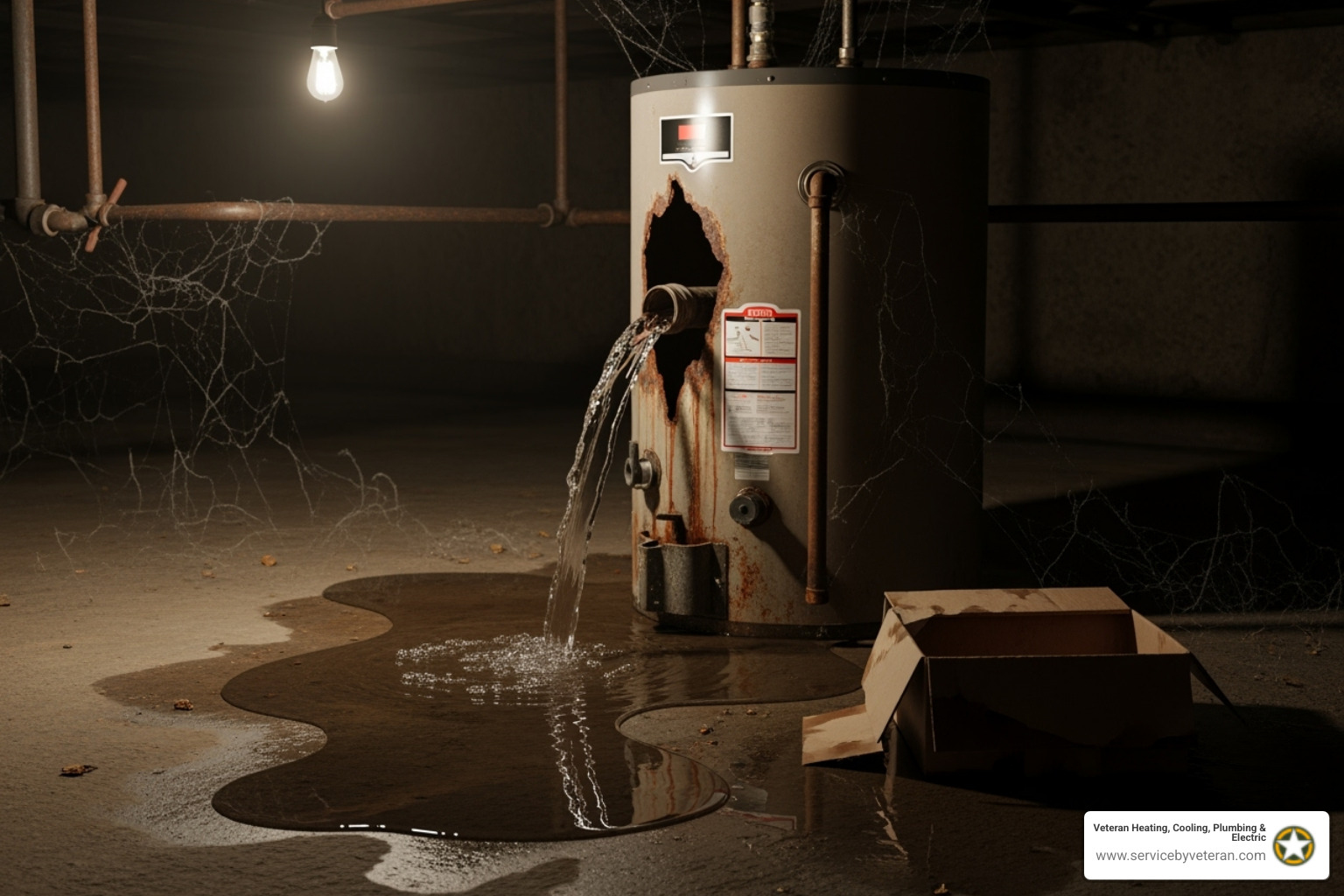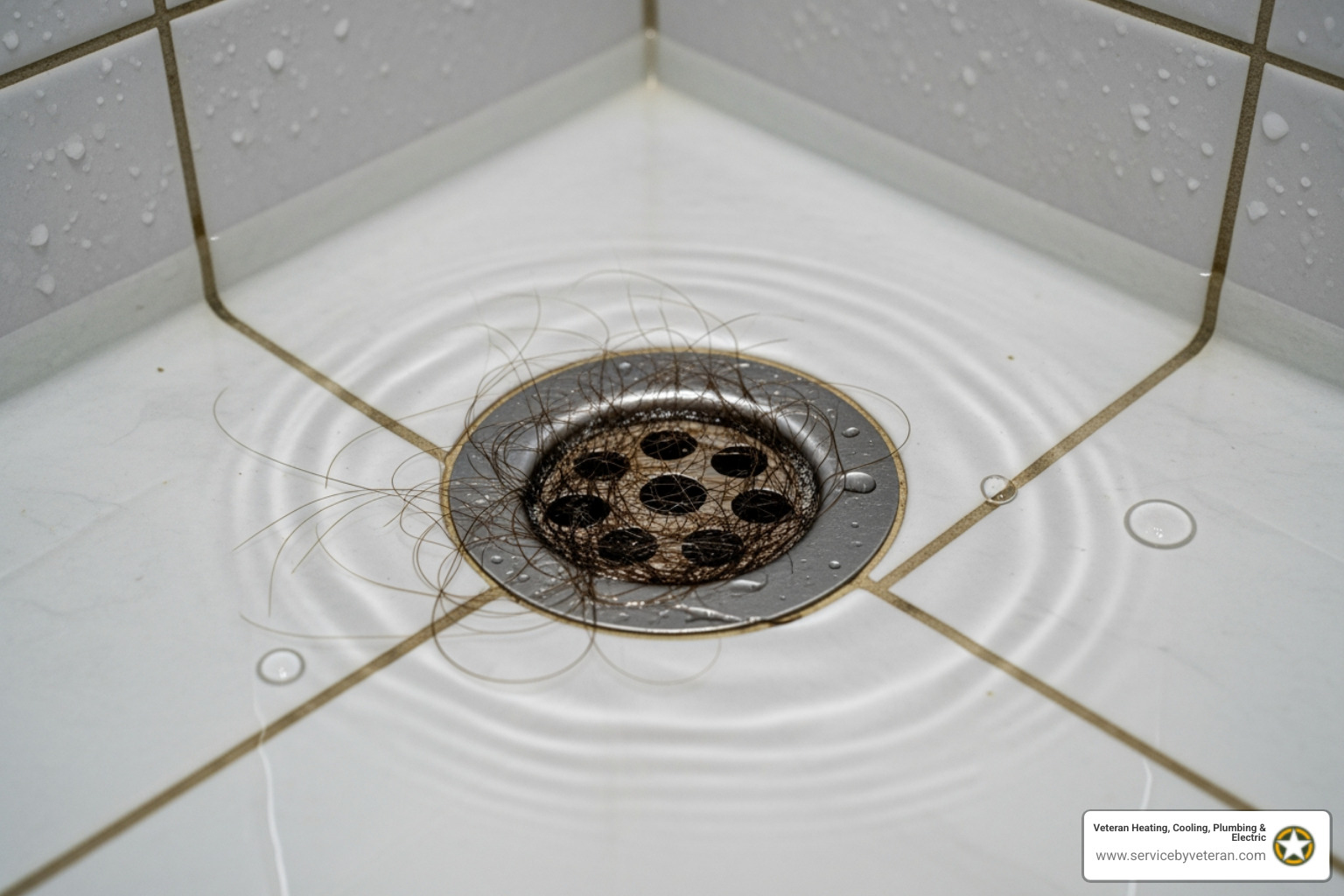Why Indoor Air Quality Should Be Your Top Priority
Air quality improvement starts with understanding a shocking truth: the air inside your home can be 2 to 5 times more polluted than outdoor air, according to the EPA. With Americans spending 90% of their time indoors, this invisible threat affects your family's health every single day.
Quick Air Quality Improvement Solutions:
- Change HVAC filters regularly - Use MERV-13 rated filters and replace every 1-3 months
- Increase ventilation - Open windows for 10+ minutes daily when outdoor air quality is good
- Control pollution sources - Keep your home smokefree and use natural cleaning products
- Maintain proper humidity - Keep levels between 30-50% to prevent mold growth
- Test for radon - This invisible gas is the second leading cause of lung cancer
Poor indoor air quality triggers immediate symptoms like headaches, eye irritation, and coughing. Long-term exposure can lead to serious health problems including asthma, heart disease, and even cancer. The good news? You have more control over your indoor environment than you might think.
Your HVAC system plays a crucial role in air quality improvement, but it's just one piece of the puzzle. Small changes in how you clean, ventilate, and maintain your home can create dramatic improvements in the air your family breathes.
I'm Mike Townsend, and my experience managing precision cooling systems for heat-seeking missile heads in the U.S. Army taught me that air quality improvement requires the same attention to detail I now bring to helping Denver-area homeowners create healthier indoor environments. Through strategic HVAC optimization and proven filtration techniques, we can transform your home's air quality using practical, cost-effective solutions.
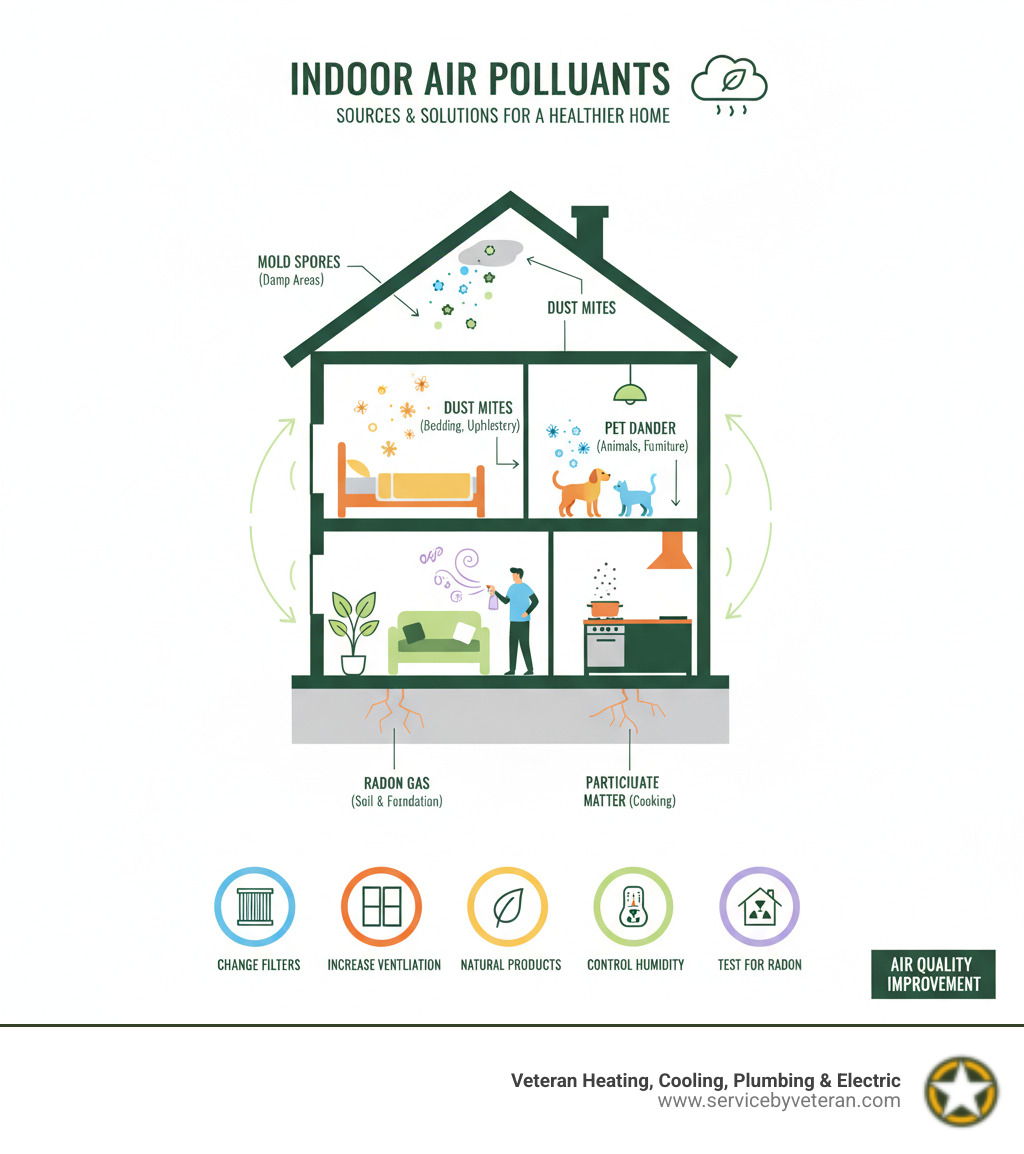
Understanding the Enemy: Common Causes and Health Effects of Poor Indoor Air
Think your home is a safe haven from pollution? Think again. The invisible enemies lurking in your living spaces might surprise you – and they're probably affecting your family's health right now.
The Invisible Intruders in Your Home
Every day, you're sharing your home with uninvited guests you can't see, smell, or touch. These air quality improvement challenges hide in plain sight, making your indoor air potentially more dangerous than the air outside.
Volatile Organic Compounds (VOCs) are everywhere in your home. That fresh paint smell? Those are VOCs off-gassing into your air. Your cleaning supplies, air fresheners, new furniture, and even that carpet you installed last year are quietly releasing these chemical gases. The scary part? Some VOCs can cause cancer and damage your central nervous system.
Particulate Matter (PM2.5) sounds technical, but it's simply tiny particles floating in your air – so small they're 30 times thinner than a human hair. Every time you cook dinner, light a candle, or use your fireplace, you're creating these microscopic invaders. They're small enough to slip deep into your lungs and even enter your bloodstream.
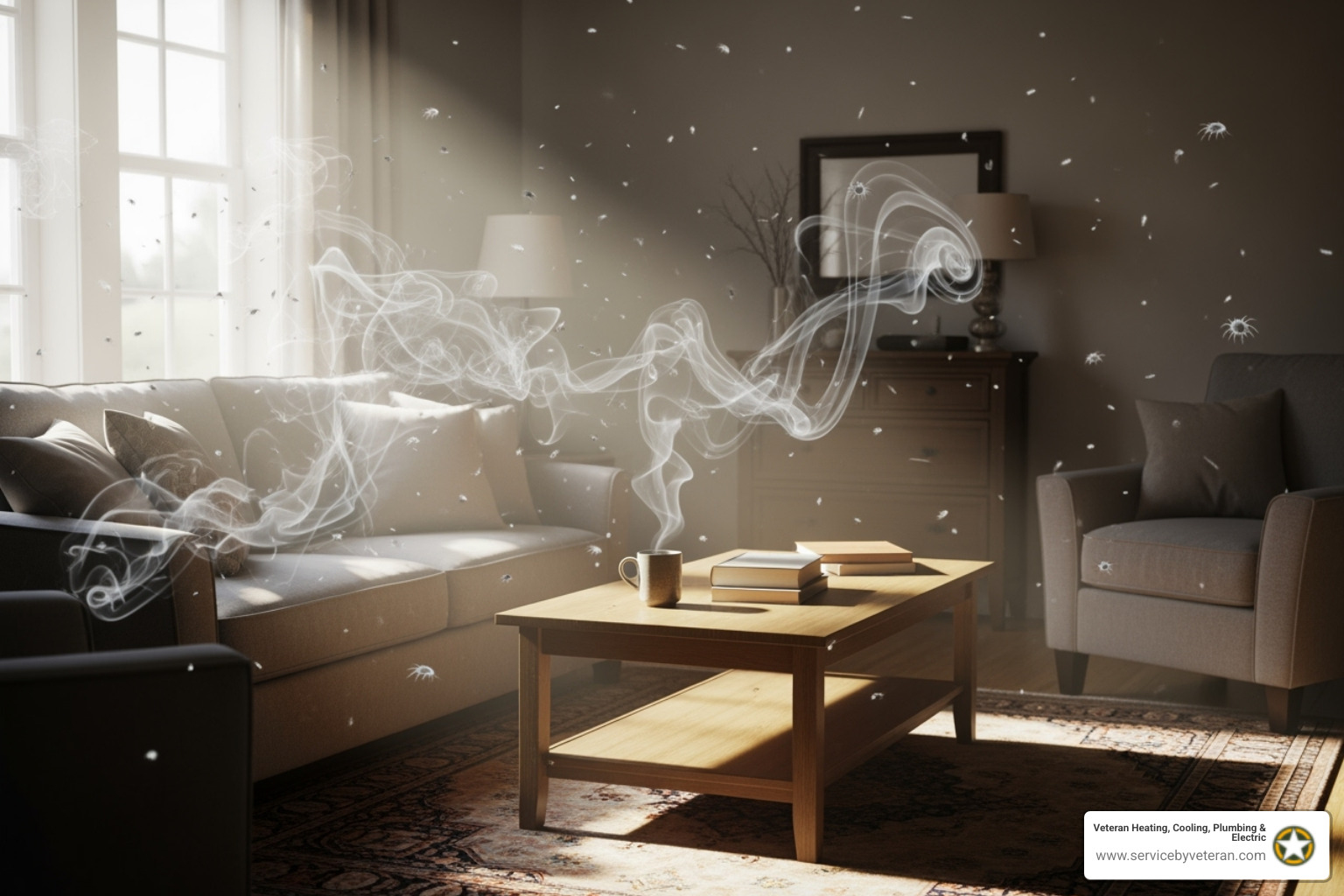
Biological pollutants include the not-so-pleasant reality of mold spores thriving in your bathroom, dust mites making themselves at home in your bedding, and pet dander from Fluffy floating through every room. These living pollutants love nothing more than triggering your allergies and asthma attacks.
Combustion pollutants come from anything that burns in your home. Your gas stove releases nitrogen dioxide every time you cook. Your furnace can leak carbon monoxide if it's not properly maintained. Even that romantic candle dinner creates fine particles that your lungs don't appreciate.
Then there's radon – the ultimate stealth pollutant. This radioactive gas seeps up from the ground into your home, and you'll never know it's there without testing. It's the second leading cause of lung cancer in America, and it could be accumulating in your basement right now.
Why Indoor Air Quality Matters for Your Health
Your body doesn't lie – it tells you when your indoor air needs help. Those afternoon headaches might not be from work stress. That scratchy throat and eye irritation could be your home's air quality crying for attention. Coughing fits and skin irritation often point to invisible pollutants floating around your living spaces.
But the real concern goes beyond daily discomfort. Poor air quality improvement neglect can trigger serious asthma attacks and worsen existing allergies. Long-term exposure opens the door to chronic respiratory diseases like bronchitis and COPD.
Your heart pays a price too. Fine particulate matter doesn't just stay in your lungs – it travels through your bloodstream, increasing your risk of cardiovascular disease and heart attacks. Some VOCs damage your blood, liver, and reproductive system over time.
The cancer risks are real. Radon exposure significantly increases lung cancer risk, while certain VOCs are known carcinogens. Children, elderly family members, and anyone with existing health conditions face the highest risks from these invisible threats.
Don't let radon stay hidden in your home. Testing is simple and affordable – get a low-cost radon test kit to protect your family from this dangerous gas.
Understanding these enemies is your first step toward cleaner, healthier indoor air. Now let's talk about fighting back with a strategic approach that actually works.
A Strategic Approach to Air Quality Improvement: The 3-Pronged Attack
Think of air quality improvement like planning a mission – you need a clear strategy that attacks the problem from multiple angles. After years of working with precision systems in the military and now helping Denver families breathe easier, I've learned that the most effective approach uses what we call the "3-Pronged Attack."
This isn't about fancy gadgets or expensive overhauls. It's about understanding three basic strategies that work together: source control (stopping pollutants at their source), ventilation (getting fresh air moving), and air cleaning (filtering what's left). When these three strategies work together, they create a powerful defense against indoor air pollution.
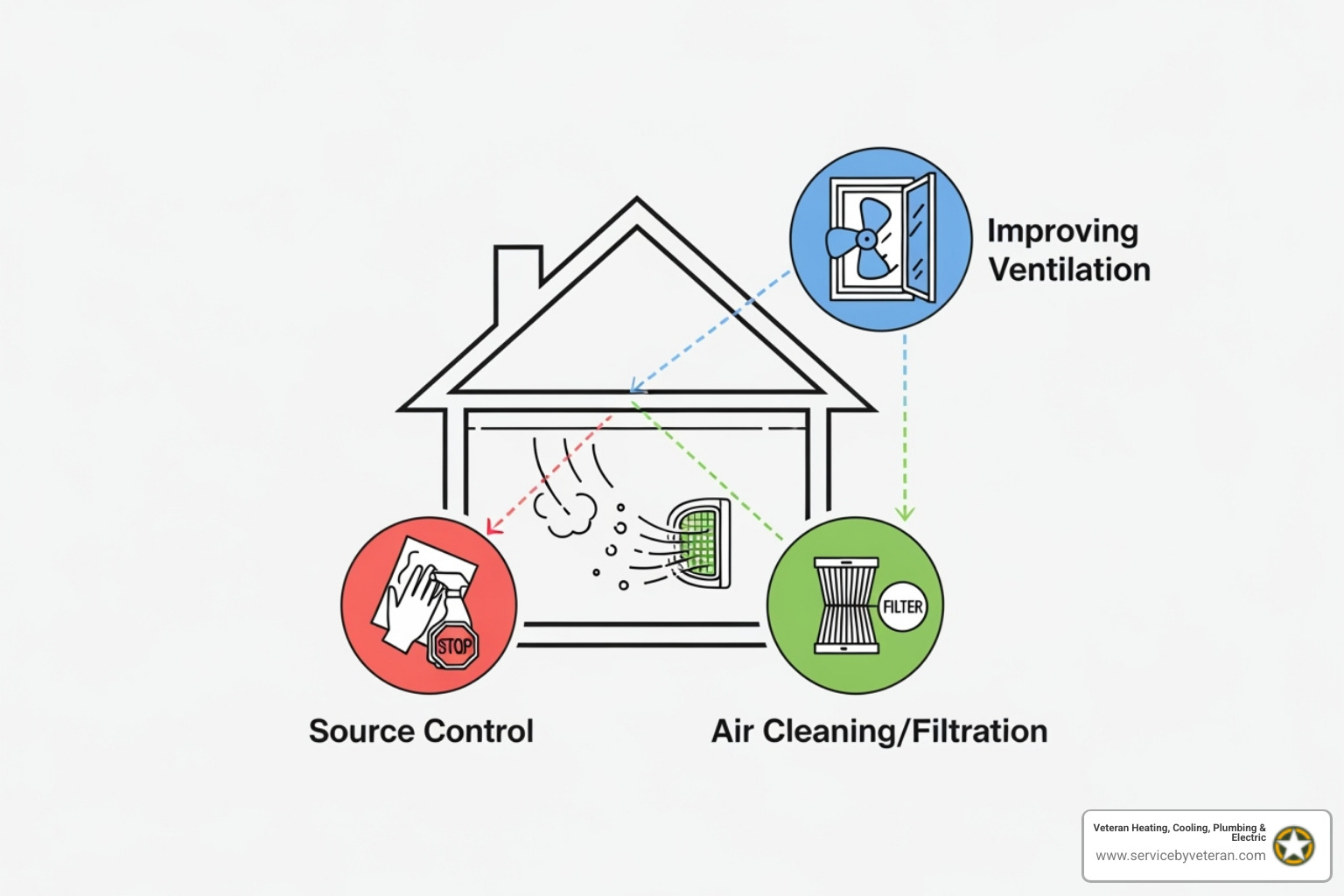
Strategy 1: Source Control
Here's the truth that might surprise you: the most effective way to improve your indoor air quality is often the cheapest. Instead of buying expensive equipment, start by eliminating or reducing the sources of pollution themselves.
Pollutant elimination is your first and strongest move. Keep your home completely smokefree – this single action dramatically improves your air quality. If you have older materials that might contain asbestos, seal or enclose them safely to prevent harmful fibers from becoming airborne.
When complete elimination isn't possible, focus on emission reduction. Choose low-VOC paints, cleaners, and furniture whenever you're shopping. Those chemical air fresheners might smell nice, but they're actually adding pollutants to your air. Natural cleaning products work just as well without the harmful emissions.
Your gas appliances need special attention too. Make sure your gas stoves, furnaces, and water heaters are properly vented to the outdoors. Regular maintenance keeps these appliances running cleanly and prevents combustion byproducts from building up inside your home.
And here's something that might seem obvious but bears mentioning: never burn trash, whether indoors or near your home. Open burning releases dangerous pollutants at much higher levels than proper disposal methods, causing eye and lung irritation, headaches, and worsening respiratory conditions.
Strategy 2: Improving Ventilation
Once you've tackled the sources, your next mission is getting that stale, polluted air out and bringing fresh air in. Think of ventilation as diluting indoor pollutants – you're essentially weakening the enemy by spreading them out.
Natural ventilation is beautifully simple and free. Opening your windows or doors for just 10 minutes each day can significantly improve your indoor air quality. Window or attic fans can boost this effect when weather permits.
But here's an important caveat: check your local air quality first. If you live near a busy freeway, factory, or during wildfire season, opening windows might actually make things worse. Sites like AirNow.gov can tell you when outdoor air quality is good enough to invite inside.
Mechanical ventilation gives you more control. Your kitchen exhaust fan isn't just for removing cooking odors – it's pulling out harmful fumes and moisture right at the source. Same with bathroom fans, which prevent the humidity that mold loves.
Here's a common misconception I encounter: many homeowners think their HVAC system automatically brings in fresh outdoor air. Most residential systems actually just recirculate and filter the air that's already inside. However, newer home designs are incorporating systems that deliberately bring in outdoor air while recovering energy through heat recovery ventilators.
Increase ventilation during high-pollutant activities like cooking, cleaning with chemicals, painting, or any kind of sanding or welding. If possible, take these activities outdoors entirely.
Strategy 3: Air Cleaning and Filtration
Even with excellent source control and ventilation, some pollutants will linger. That's where air cleaning and filtration become your final line of defense in achieving air quality improvement.
Air cleaner effectiveness depends on two key factors: how well it captures pollutants and how much air it processes. Portable HEPA air cleaners with additional charcoal filters can help neutralize both particles and odors. Just remember to maintain them according to the manufacturer's directions.
Your home's HVAC system is already moving massive amounts of air, making it a powerful ally. Upgrading to MERV-13 filters and changing them every 1-3 months can dramatically improve your indoor air quality. MERV stands for Minimum Efficiency Reporting Value – higher numbers mean better filtration of smaller particles.
While HEPA filters are excellent for particles, they're often too restrictive for residential HVAC systems without modifications. Activated carbon filters can help with gases and odors, but they become saturated quickly and need regular replacement.
You might have heard that houseplants purify air. While they do remove some chemicals in laboratory settings, scientific research shows you'd need an impractical number of them to significantly clean the air in a typical home. Don't rely on your green friends for heavy-duty air quality improvement.
For gaseous pollutants like radon, standard air cleaners aren't effective. The EPA doesn't recommend air cleaners for radon reduction because their effectiveness is uncertain – specialized mitigation systems are needed instead.
Keeping your HVAC system properly maintained is crucial for all these strategies to work effectively. Our comprehensive maintenance plans ensure your system keeps moving and filtering air efficiently, supporting your overall air quality improvement efforts.
Practical HVAC Hacks and Everyday Tips for Cleaner Air
Now that we understand the battle plan, let's roll up our sleeves and get to work! The beauty of air quality improvement is that many of the most effective steps don't require expensive equipment or complicated procedures. Some of the biggest wins come from simple HVAC optimizations and everyday habits that become second nature once you know what to look for.
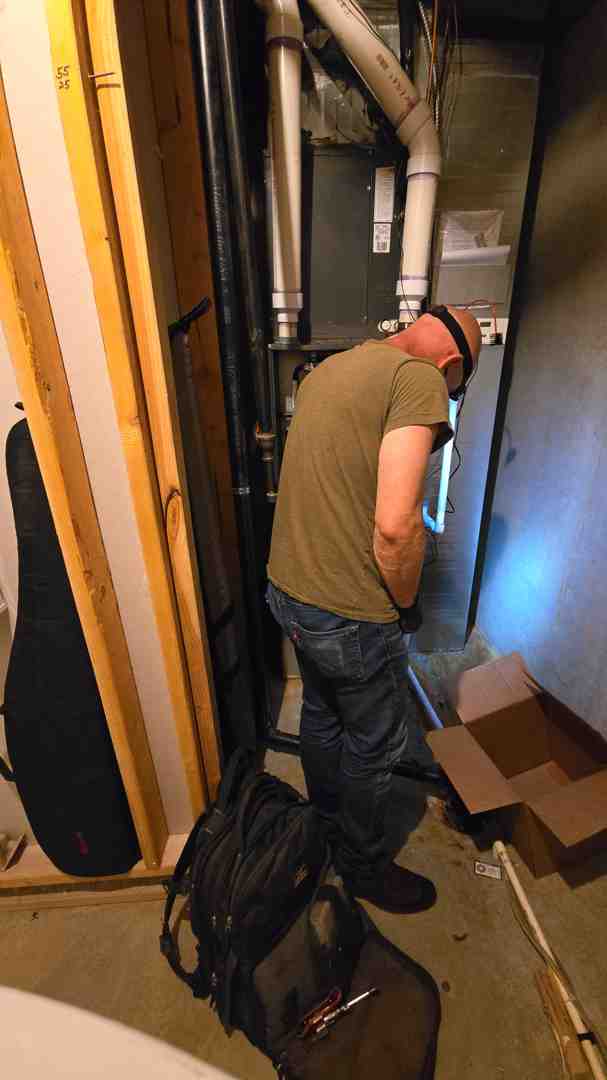
Optimizing Your HVAC for Air Quality Improvement
Think of your HVAC system as your home's respiratory system - when it's healthy and well-maintained, your whole house breathes better. During my military days working with precision air systems, I learned that consistent maintenance prevents small problems from becoming big headaches.
Regular filter changes are hands down the most impactful thing you can do for your indoor air. I recommend swapping out those filters every 1-3 months, depending on your home's specific conditions. A clogged filter is like trying to breathe through a dirty sock - it can't trap pollutants effectively and makes your system work overtime, which shows up on your energy bill.
Upgrading to MERV-13 filters is like giving your HVAC system a promotion. These high-performance filters capture smaller particles than standard filters, including bacteria, viruses, pollen, and pet dander. Just make sure your system can handle the increased resistance - our technicians can help you find the sweet spot between filtration power and proper airflow.
Ductwork inspection might not be glamorous, but it's essential. Over the years, dust, debris, and sometimes even mold can build up in your ducts. When your system kicks on, these pollutants get a free ride throughout your home. Professional duct cleaning eliminates this hidden source of contamination.
Annual system tune-ups are like getting a physical for your HVAC system. Our technicians check for proper combustion, seal any ductwork leaks, and ensure all components are clean and functioning efficiently. If you're in the Lakewood area and need expert furnace care, we provide comprehensive Furnace Repair Lakewood services to keep your system running smoothly.
Humidity control is the secret weapon many homeowners overlook. Keeping indoor humidity between 30% and 50% creates an environment where mold, mildew, and dust mites can't thrive, while preventing the respiratory irritation that comes with overly dry air. Your air conditioner naturally removes some humidity, but if you're struggling with moisture issues, a whole-home dehumidifier or humidifier integrated with your HVAC system can be a game-changer for air quality improvement.
For homeowners who want to stay on top of all these maintenance tasks without the hassle, our Maintenance Plans take care of filter changes, system checks, and tune-ups so you can focus on enjoying cleaner air.
Low-Cost Ways to Improve Your Home's Air
Here's the good news: you don't need to spend a fortune to breathe easier. Some of the most effective air quality improvement strategies cost virtually nothing and just require developing better habits.
Regular cleaning becomes much more meaningful when you realize that household dust isn't just dirt - it's a cocktail of dead skin cells, dust mite droppings, pet dander, and other airborne particles. Vacuuming carpets and rugs with a HEPA-filter vacuum removes these pollutants before they can recirculate. When dusting, use a microfiber or damp cloth that actually traps particles instead of just moving them around. Washing bedding in hot water weekly helps control dust mites that love to make themselves at home in our sheets.
Managing humidity levels doesn't always require expensive equipment. In humid climates, running exhaust fans during showers and cooking helps remove excess moisture. In dry climates, even a bowl of water near heating vents can add beneficial moisture to the air.
Using natural cleaning products is both budget-friendly and lung-friendly. Vinegar, baking soda, and lemon juice are surprisingly effective cleaners that won't fill your home with volatile organic compounds. Skip the aerosol sprays and chemical air fresheners - they're just adding more pollutants to the mix.
Keeping your home smokefree is non-negotiable for good indoor air quality. This includes being mindful of what you burn indoors - even scented candles can release pollutants, though beeswax and soy candles are much cleaner options than paraffin.
Opening windows strategically can work wonders when outdoor air quality is good. Just 10 minutes of fresh air circulation daily can dilute indoor pollutants significantly. Living in the Denver area, we're blessed with generally good outdoor air quality, so take advantage of those beautiful Colorado days!
Testing for radon is one of those "better safe than sorry" investments. Since this dangerous gas is completely invisible and odorless, testing is the only way to know if your family is at risk. Get a low-cost radon test kit and gain peace of mind.
The beauty of these approaches is that small, consistent actions add up to significant improvements in your home's air quality. You don't need to tackle everything at once - start with what feels manageable and build from there.
Frequently Asked Questions about Home Air Quality Improvement
Over the years, I've heard countless questions from homeowners who are genuinely concerned about the air their families breathe. These questions come from real experiences – that lingering chemical smell after cleaning, concerns about their child's worsening asthma, or simply wanting to create the healthiest possible environment. Let me share the most common questions and the practical answers that can make a real difference in your home.
What are the three basic strategies to improve indoor air quality?
Think of air quality improvement like defending your home from unwanted intruders – you need a comprehensive strategy, not just one approach. The three fundamental strategies work together like a well-coordinated defense system:
Source Control is your first and most powerful line of defense. This means eliminating or reducing individual sources of pollution before they can spread throughout your home. It's often the most effective and cost-efficient approach because you're stopping the problem at its root. Think of it like fixing a leaky faucet instead of constantly mopping up the water.
Ventilation brings fresh outdoor air indoors to dilute any pollutants that do make it into your home. This can be as simple as opening windows for ten minutes each day or as sophisticated as mechanical systems with dedicated outdoor air intakes. The key is getting that stale, polluted air out and bringing clean air in.
Air Cleaning and Filtration acts as your final safety net, using air cleaners and filters – especially those in your HVAC system – to capture particles and some gaseous pollutants that ventilation might miss. Your HVAC filter is working around the clock to trap dust, pollen, and other airborne particles before they circulate through your home.
How can I reduce vehicle emissions to help outdoor air quality?
Your vehicle choices don't just affect the air outside – they directly impact the quality of outdoor air that eventually makes its way into your home. Every gallon of gas you don't burn helps create cleaner outdoor air for everyone in your community.
Driving less makes the biggest impact. The American Public Transportation Association found that public transportation produces 95% less carbon monoxide and over 92% fewer volatile organic compounds per passenger mile compared to private vehicles. Even carpooling, biking, or walking for short trips adds up to significant improvements.
Consolidating your errands into single trips reduces your total driving miles and saves you time and money. Maintaining your vehicle properly – including its emissions control systems and keeping tires properly inflated – ensures your car runs as cleanly as possible.
Avoiding idling is simpler than you might think. Turning off your engine while waiting in drive-thrus, at school pick-up, or during quick stops prevents unnecessary emissions from polluting the air around you and your community.
When refueling, stop at the first click to avoid releasing fumes, and try to refuel during cooler parts of the day, especially in summer, to minimize gasoline vapor emissions. When it's time for a new vehicle, choosing one with better fuel economy can save you around $615 per year while significantly reducing your environmental impact.
For more detailed tips on fuel efficiency and choosing greener vehicles, check out FuelEconomy.Gov.
Are houseplants effective at purifying indoor air?
I hate to be the bearer of disappointing news for all the plant lovers out there, but this is one of those beautiful myths that science just doesn't support for real-world applications. While indoor plants are wonderful for our mental health and add life to our homes, their ability to significantly purify indoor air is often greatly overestimated.
Laboratory experiments have shown that certain plants can remove some chemicals from the air under controlled conditions. However, scientific research suggests that you would need an impractical number of plants – we're talking hundreds or even thousands – to make a measurable impact on air quality in a typical home or office.
The reality is that your fiddle-leaf fig, while gorgeous, simply can't compete with a good HVAC filter or proper ventilation for serious air quality improvement. Keep your plants for the joy they bring, but rely on proven strategies like source control, ventilation, and mechanical filtration to actually clean your air.
This doesn't mean plants are useless – they're fantastic for improving your mood and creating a more pleasant living environment. Just don't expect them to replace the fundamental strategies that actually work for cleaner indoor air.
Breathe Easier with a Healthier Home
Creating a home where you can truly breathe easy isn't about perfection—it's about making smart, consistent choices that add up to real air quality improvement. Think of it like staying in shape: you don't need to run a marathon tomorrow, but taking the stairs instead of the elevator makes a difference over time.
Our three-pronged strategy gives you a clear roadmap: control pollution sources, improve ventilation, and use effective filtration. The beauty of this approach is that you can start anywhere. Maybe you begin by switching to natural cleaning products this week, then upgrade your HVAC filter next month. Every step forward counts.
Your HVAC system deserves special attention because it's working around the clock to move air throughout your home. Regular filter changes, annual tune-ups, and proper maintenance aren't just suggestions—they're essential for keeping your indoor air clean and your family healthy. When your system needs expert care, our team brings the same precision and attention to detail that served us well in the military to every home we serve.
We've seen how small changes can create dramatic improvements. A homeowner in Lakewood recently told us that simply upgrading to MERV-13 filters and scheduling regular maintenance eliminated her family's persistent morning headaches. Another family in Westminster finded that fixing a small duct leak and improving their kitchen ventilation made their home feel fresher than it had in years.
The most important thing to remember is that air quality improvement is an investment in your family's health and comfort. With our lifetime warranty on parts and labor, plus our money-back guarantee, you can trust that we'll be there to support your journey toward cleaner indoor air. We're proud to serve families throughout Denver, Lakewood, Littleton, Wheat Ridge, Aurora, Westminster, Arvada, Castle Rock, and all the communities we call home.
Don't let another day go by breathing air that could be cleaner and healthier. Small changes today lead to big improvements tomorrow, and your lungs—and your family—will thank you for it.
Ready to transform your home's air quality? Explore Our Services and let's work together to help you breathe easier, starting today.


